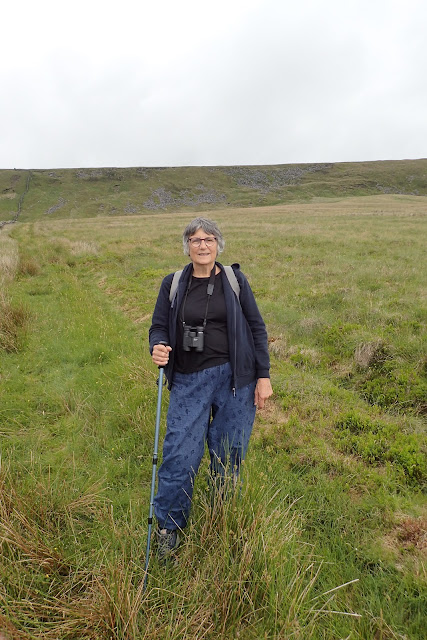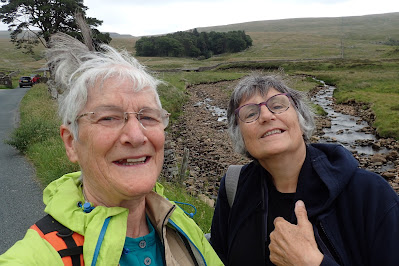 |
| Wonderful lichen laden post at Kingsdale Head that I only noticed after everyone had gone (See end of post). |
Pictures from the day: held in the far NW of VC64 - WNW Yorkshire are posted at the end of this account
(Geology: Top of a glaciated valley cut through the Yoredale series (Repeating limestone, sandstone, shale layers, with one millstone grit at the top of hills Gragareth/Greenhill and Whernside. Whernsisde (736m) and Green Hill (628m) are the highest peaks in Yorkshire and Lancashire respectively. Green Hill adjacent to Cumbria is about 1.8km along the ridge from Gragareth (627m) adjacent to Yorkshire. .
Land use: Former sheep grazing moorland, with a couple of "Inby fields" next to the farm. Now the estate is being "Rewilded". In the areas with peatbog, the drainage ditches have been blocked. There is low grazing with ten cattle.
(See also the report from the pretrip visit on 1 July)
Parts of Britain may have been having a heat wave . The East and South of Yorkshire YNU members reported that the land there is parched.
Not so in Kingsdale. Very much a green and pleasant land.
And on our chosen day for the YNU excursion, sadly rain was forecast, and had come along with strong winds on the previous evening.
"Well done!" to the seventeen brave souls who made it all the way to the farm, 310m above sea level, .. and just three miles from Cumbria. Fortunately, the Kingsdale Head Farm had an excellent meeting room set up in a very big barn with tables chairs, a boiler with hot water and if we had needed it, a large display board. Patrick an ecology student from America was here at the farm gaining work experience to help us.
I live c 17 miles away (11 miles as the crow flies) - 30 min drive if traffic is good - and made no effort to get up early, as the drier part of the day was forecast to be later rather than earlier. So I missed seeing the opening of the moth traps.
It was good to have time to chat with people who had come from Barnsley and Brockadale towards Doncaster - just about 78 miles away). Our YNU Journal Editor had made it and also our YNU President.
Five members of Craven Conservation Group took part: Terry Whitaker from Bentham had organised the event and today was accompanied by CCG member Dave Fisher from Bentham. CCG member Cynthia Hardyman had been there earlier taking part in opening the moth traps. Later in the day Geoff Morries came.
So we set off walking up the road, which ran parallel to the river - This might have been a good place for searching for water creatures three days ago, but now the river was really high and fast flowing.
As the raindrops settled on my glasses, I wished that I still could use occasional contact lenses, like I used to do, about 20 years ago.
We came the wood at Cluntering Gill (Whiteside Wood), planted at some time in the past. The first tree in the wood was an alder and had a tuft of the pastel green foliose lichen Ramalina farinacea growing on the branch overhanging the path... in front of my nose, and big enough for me to see through my rain droppy drippy misted glasses..
It was at this point I discovered I had left my best hand lens (part of my Swiss Army penknife) - at home. Huh. The second spare lens in one I found (in one of the 15 pockets available in my three water proofs, waistcoat, jumper and trousers ) was not very good. Then I looked up and discovered everyone else had disappeared, off up the gill.
So I decided to go back to the farm and my car and see if I had a spare lens there. Various lichens on the roadside wall and the river sidetracked me. There were saplings and rose bush saplings planted by the river. .. I returned to the car. Hurray - I HAD put a my spare penknife (with lens) in the car. I was very HAPPY. I was pleased I had been so prepared for once).
Everyone else returned shortly for lunch.
In the afternoon the rain semi-cleared up and the mist/cloud level moved to about 500m (i.e. we still couldn't see the tops of the hills)
We went as a group to another wood: Blackside Wood -well old conifer plantation on a steep slope, which had a band of limestone in it we were told. It had one huge Sitka spruce tree with a very wide trunk.
Derek explained to me how to recognise Omocestus viridula - the common green grasshopper; We found Peltigera praetextata lichen covering a boulder. This is a dog lichen with a rugose (crinkle/puckered) thallus (As in P membranacea) but the edge of the thallus can have crinkled edges/crinkly isidia. The conifers only had a little lichen on the trunks - the types that are happy on acid bark.- such as Hypogymnia physodes.
We found the band of Yoredale Limestone. It even had a few ash trees growing on it. One with more P. praetextata.
"Whats that?" said Joyce, pointing to a 2cm pale grey round lobe on the damp limestone ledge- and it turned out to be Dermatocarpon miniatum lichen - "Spotty Elephant Ears" is my invented name for it.
Then there was a green squamulose lichen spilling out of a nearby crevice. It was made of lots of lobes - squamules about 5mm across. "Looks like a very wet patch of Squamarina cartilaginea" I said, but then wished I hadn't because it wasn't S cartilaginea.- it had sunken fruit, not flat or raised apothecia.
It turned out to be Placidium squamarinum - It was bigger than any I have seen near Settle - It grows in crevices in some walls and limestone cliff faces and is brown when dry.. this one was bright green mottled with paler bits, and the patch about 4cm across. Still, it was growing on a ledge of a clifflet.
By the time I had thought about it everyone had gone. Again. I retraced my steps and found one of the group - Peter Guerney. We walked down through the wood. Peter pointed out two birds nests to me that I would neve have noticed - holes in trees.. Suddenly at the bottom of the wood I found a large beech with good lichens on a branch (compared to the sitka spruce) -well normal deciduous tree lichens - Ramalina farinacea, Xanthoria parietina. For some reason this beech had been 3/4 ring barked - but was surviving because the back part next to the rock had not been accessible to the axe.
Back down the path and almost at the road we saw some Alchemilla mollis (Garden Alchemilla) - this according to the BSBI 2020 atlas has increased more than any other species in Britain recently. .. and here it was right up here.
Back at the farm meeting room, we enjoyed the cake that Terry had brought. I showed people the stamps I had just bought - Fungi (issued on 1 July). Including one we had seen on this afternoons walk - Turkeytails. - Derek chaired the meeting and Terry was secretary. We had a roll call of societies. We looked at a collected Satin Moth.
Derek said he would come back later in the week when the sun is out and record more insects.
Geoff and I helped Terry remove stuff he had brought and tidy the room. Geoff and Terry left.
"I'll just record a few lichens on the concrete block wall -part of the farm - whilst we are here with permission at the farm. A different habitat." I thought.
Then I saw the post
Stood on the grass on the slope below where we had parked out cars.
Wonderful.
I was able to name 10 lichens on the post - mostly big ones.. and see at least three others that I could not name.
Pseudevernia furfuracea
Parmelia saxatilis
Punctellia subrudecta
Hypotrachyna afrorevoluta
Hypogymnia physodes
Melanelixia glabratula
Physcia tenella
Xanthoria ucrainica
Candelariella vitellina
Trapeliopsis flexuosa
 |
| Picture taken by our Whatsapp group |
 |
| Polypodium sp ? vulgare and a tuft of Tortella tortuosa moss below it - there were old limestone stones in the wall. On the wall between the farm and Cluntering Gill |
 |
| Cladonia species -wet |
 |
| Physcia caesia - wet |
 |
| Derek surveys the river.. and points out it is not a good day for sweep netting. |
 |
| Lunch |
 |
| Common Green Grasshopper - Omocestus viridulis |

 |
| A non-native plant in the wood - it is liable to spread an take over. |
 |
| Peltigera praetextata - Dog lichen covering a boulder. |
 |
| Can you see the frilly edges to the thallus? or the Peltigera praetextata? |
 |
| We came to the limestone area - a patch of pavement covered in limestone loving mosses.. and the ash tree in the centre had Peltigera praetextata growing up its trunk. |
 |
| Look at the bright copper apothecia on thsi piece. |
 |
| A photo looking up to remind me se were standing under ash. |
 |
| There was a mini 1 m tall clifflet in the wood - there must be a better geological term for the edge of a band of limestone |
 |
| This was the surprisingly large patch of Placidium squamulosum 4cm across |
 |
| Close up of the Placidium squamulosum. |
 |
| Extreme close-up of the Placidium squamulosum. |
 |
| Extreme close-up of the Placidium squamulosum. |
 |
| The damaged beech - see base. |






































